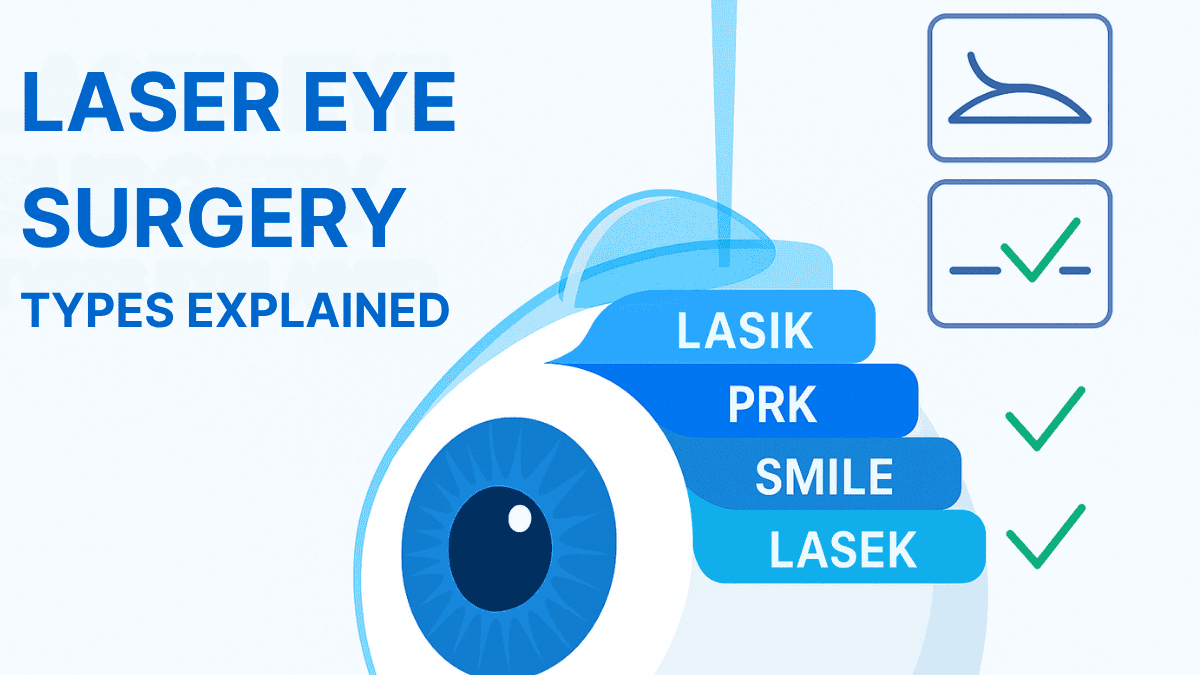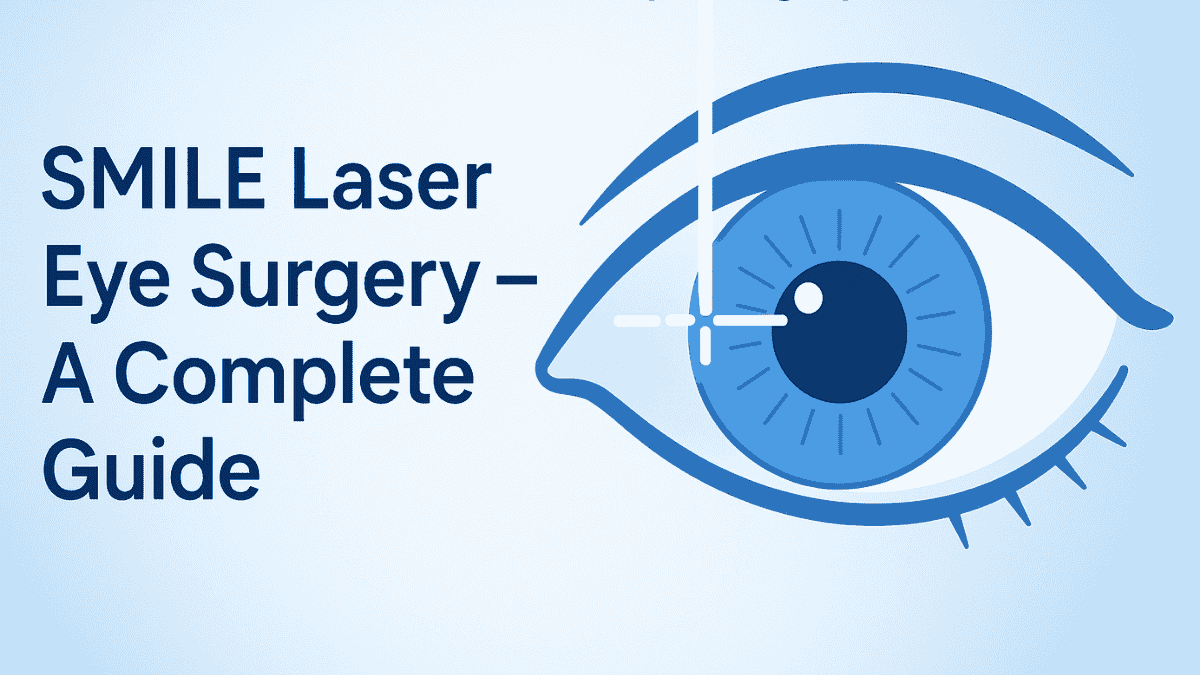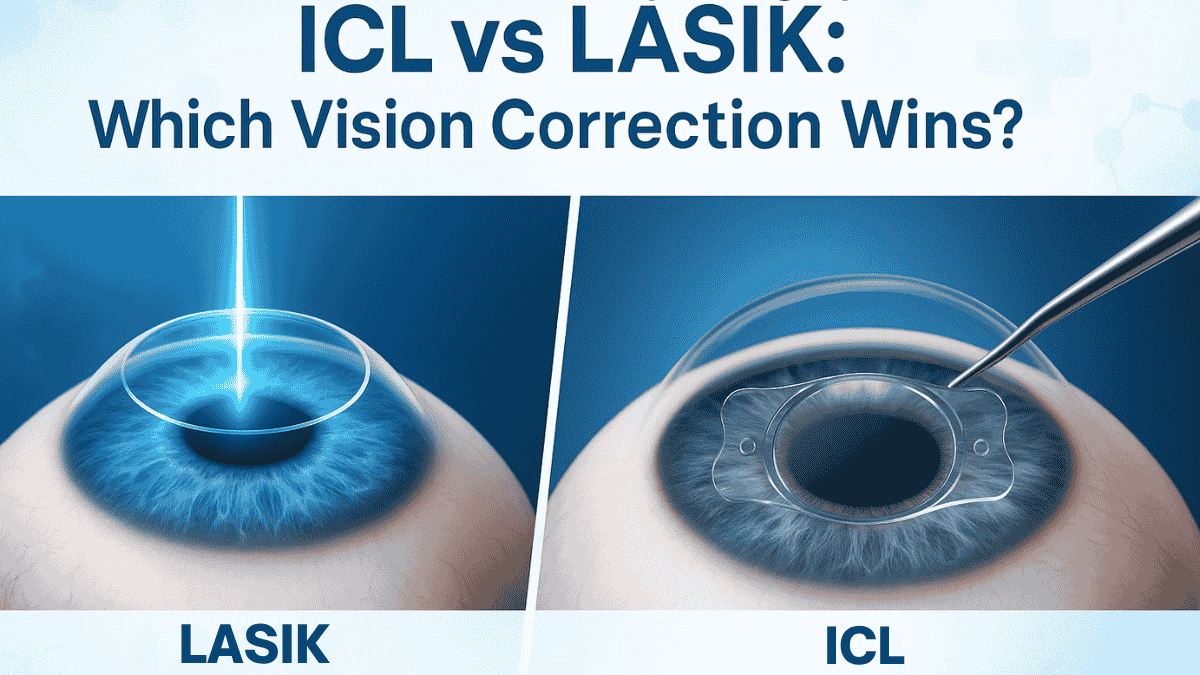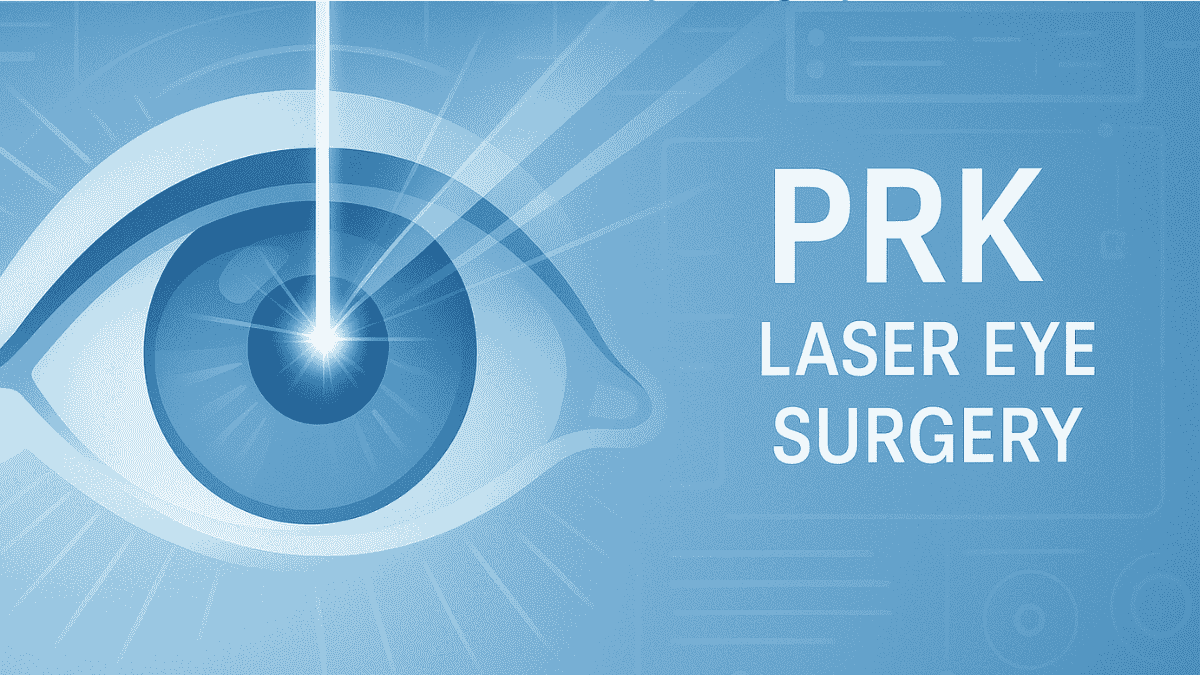
Considering PRK surgery? This photorefractive keratectomy procedure offers a path to freedom from glasses or contact lenses for many. If you’re looking into this type of laser eye surgery, understanding the details is important. This guide will explore what PRK entails, from the actual surgery procedure to the typical surgery recovery and long-term eye care.
Table of Contents
What is PRK Surgery?
PRK stands for photorefractive keratectomy. It is a type of refractive surgery that utilizes an advanced excimer laser to reshape the cornea, thereby improving how your eye focuses light. PRK was the pioneering laser eye surgery developed for vision correction, introduced even before the more widely known LASIK procedure.
The cornea is the transparent front part of your eye that covers the iris and pupil; its primary function is to bend light, or refract it, to help create a sharply focused image on the retina at the back of the eye. In photorefractive keratectomy surgery, the eye surgeon begins by gently removing the epithelium, which is the cornea’s very thin outermost layer. Following this, a highly precise excimer laser carefully ablates, or removes, microscopic amounts of corneal tissue, which effectively reshapes the cornea to correct the eye’s refractive error and improve overall vision. This laser treatment is specifically programmed to address common vision problems such as nearsightedness, farsightedness, and astigmatism. Many benefits of PRK include its suitability for certain corneal conditions.
How PRK Differs from LASIK
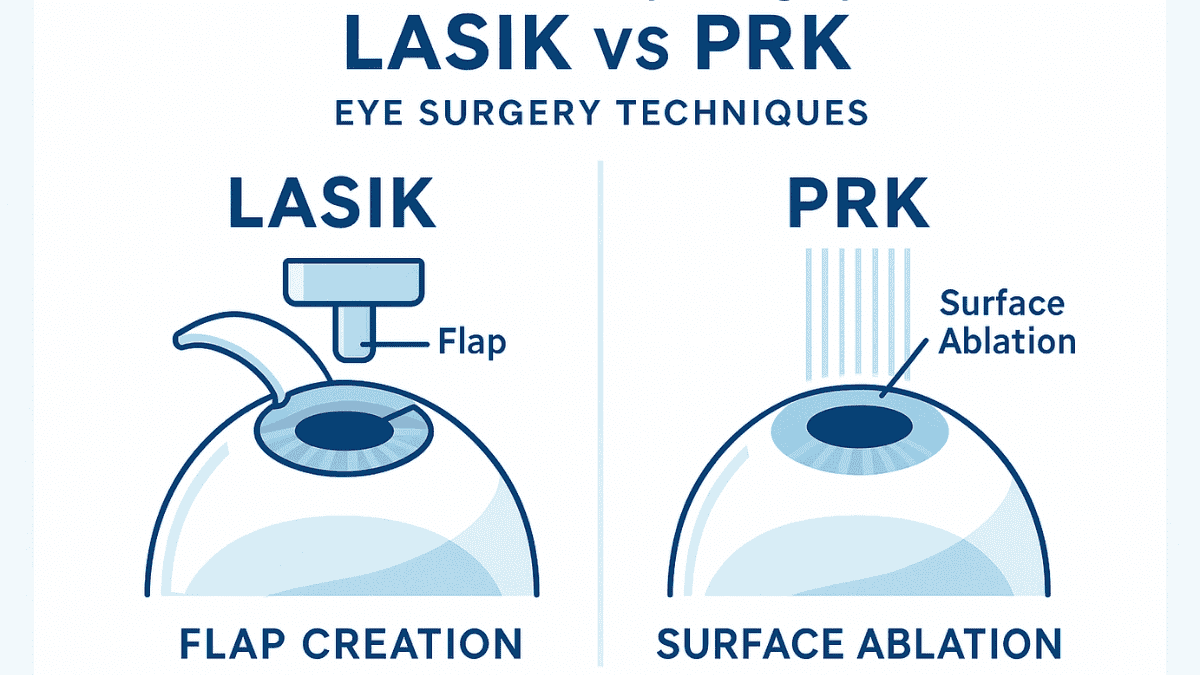
Both PRK, also known as laser photorefractive keratectomy, and LASIK (laser-assisted in situ keratomileusis) are forms of laser eye surgery aimed at vision correction, but they employ distinctly different techniques. LASIK involves the creation of a thin corneal flap by the eye surgeon. This flap is carefully lifted to expose the underlying corneal stroma, which is then reshaped by an excimer laser, after which the flap is repositioned over the treated area.
Conversely, PRK surgery avoids the creation of any corneal flap. Instead, the surgeon removes the epithelium, the thin outer layer of the cornea, typically after an alcohol solution is applied to loosen it, before applying the laser to reshape the cornea’s surface. This fundamental difference means there is no risk of flap-related complications with PRK eye procedures, which can sometimes occur with LASIK. The absence of a corneal flap makes PRK eye surgery a preferred laser option for certain patients.
Because no corneal flap is created, PRK can be a safer alternative for individuals with thinner corneas or those whose occupations or active lifestyles place them at a higher risk for eye trauma where a flap could be dislodged. The lack of a flap also eliminates concerns about flap displacement, wrinkles, or inflammation beneath the flap (like diffuse lamellar keratitis) that, while uncommon, can occur after LASIK. This distinction is important for comprehensive eye care considerations and choosing the most appropriate laser vision correction method. Many patients find that laser photorefractive treatment gives them great results.
Who’s a Good Candidate for PRK?
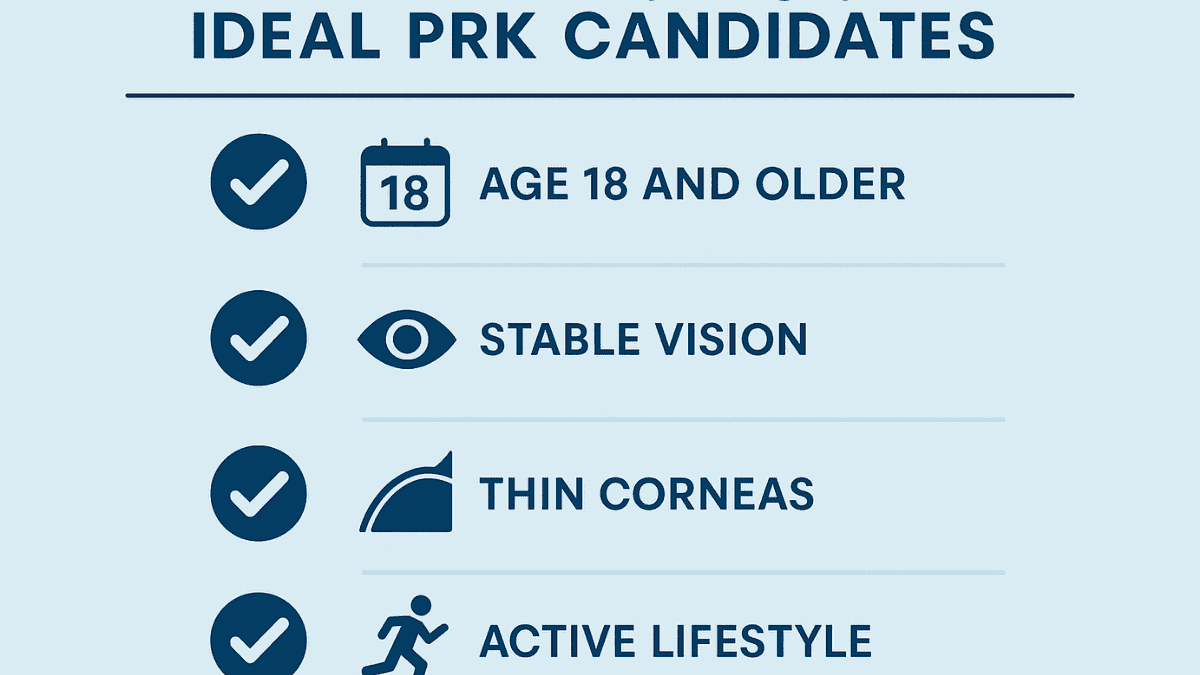
Determining if PRK surgery is the right choice for your vision problems involves a comprehensive eye exam and a detailed discussion with an experienced eye surgeon. Several factors contribute to establishing good candidacy for this specific vision correction procedure. You might be suitable for PRK treatment if you meet particular criteria established through this evaluation.
Generally, ideal candidates for PRK include adults who are at least 18 years old, though many surgeons prefer patients to be 21, with vision that has been stable for at least one year. This stability means your prescription for glasses or contact lenses has not undergone significant changes recently. Your specific refractive error, whether it is myopia (nearsightedness) allowing you to treat myopia, hyperopia (farsightedness), or astigmatism, should fall within the range that PRK can effectively correct; this procedure is often suitable even for individuals with a high refractive error.
PRK is frequently recommended for individuals whose corneas are too thin for LASIK, as creating a flap in such cases might compromise corneal integrity. People with very active lifestyles, those participating in contact sports, or individuals in professions such as the military or law enforcement often find PRK appealing due to the absence of a corneal flap, which reduces the risk of flap-related injuries. Good overall eye health is also crucial; candidates should be free from conditions like uncontrolled diabetes, active corneal infection, advanced glaucoma, or severe dry eye syndrome, although mild to moderate dry eye can often be managed. Having realistic expectations about the surgery recovery timeline and the visual outcomes is vital for patient satisfaction. PRK is distinct from cataract surgery, which addresses a clouded lens typically by implanting an intraocular lens.
Related Article
LASIK Eligibility TestWhat to Expect During PRK Surgery
Understanding the PRK surgery procedure can help reduce any anxiety you may have about the laser eye surgery. This type of laser surgery is performed as an outpatient surgery, which means you will be able to return home on the same day. The entire process for both eyes usually takes about 15 to 30 minutes to complete from start to finish.
Initially, your eye surgeon will administer anesthetic eye drops to completely numb your eye surface, so you will not feel pain during the procedure; no injections are typically needed for anesthesia. You will be awake and aware during the PRK laser surgery but should feel comfortable. A small instrument called a lid speculum will be gently placed to keep your eyelids open, preventing you from blinking during the laser treatment.
The surgeon then carefully removes the epithelium, the cornea’s thin outer protective layer. This may be done using a specialized brush, blade, or sometimes an alcohol solution is applied briefly to help loosen the epithelial cells. You will be asked to focus on a blinking target light to help keep your eye correctly aligned. The excimer laser, which has been precisely pre-programmed with your individual prescription details obtained from your eye exam, then sculpts the cornea’s surface by emitting pulses of cool ultraviolet light that remove microscopic layers of tissue. You might hear a soft clicking sound as the laser operates. The laser removes tissue with remarkable precision to correct vision.
After the laser treatment is finished, which usually takes less than a minute per eye, a clear, soft bandage contact lens is placed on the eye. This special lens serves to protect the eye surface, reduce eye pain, and promote comfort during the initial healing process while the epithelium, the outer layer of the cornea, naturally regenerates or cornea grows back. You will then receive specific instructions for eye drop usage, including antibiotics and anti-inflammatory medications, and other post-operative eye care measures. This bandage contact helps shield the healing cornea.
Recovery After PRK Surgery
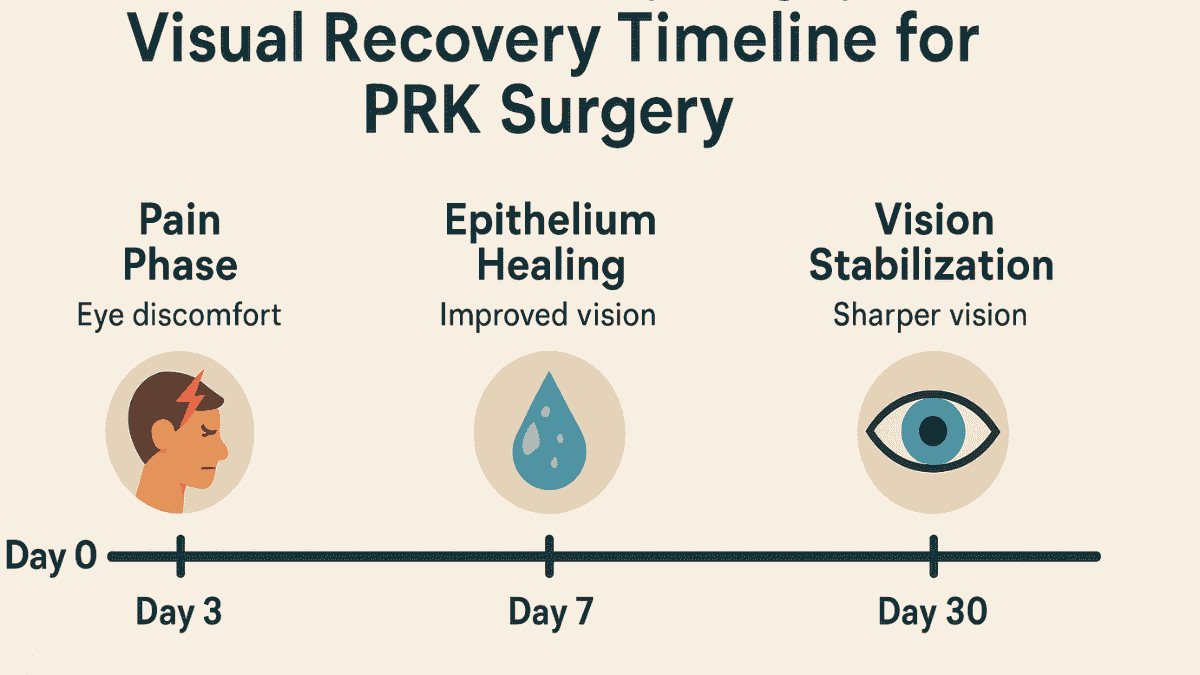
The PRK surgery recovery period is generally longer and often involves more initial discomfort when compared to recovery from LASIK. This is because the outermost layer of the cornea, the epithelium, needs time to regenerate completely over the treated area. Understanding the typical healing process timeline can help you set realistic expectations for your vision correction journey. Your vision will gradually improve over a period of weeks or sometimes even months.
Immediately following the PRK laser surgery, your vision will likely be quite blurry. You will have a protective bandage contact lens on each treated eye, which aids in healing and comfort. It is common to experience moderate eye pain, significant light sensitivity (photophobia), excessive tearing, and a gritty or foreign body sensation in your eyes for the first few days. Your eye surgeon will prescribe medicated eye drops, including pain relievers, antibiotics to prevent corneal infection, and anti-inflammatory agents (steroids), to manage discomfort and support the healing process. You must arrange for someone to drive you home from the surgery center, as you will be unable to drive.
The first 3 to 5 days post-surgery are typically the most uncomfortable phase of the healing process as the corneal epithelium actively regrows to cover the exposed eye surface. During this critical time, it is crucial to use your prescribed eye drops diligently according to the schedule provided; this drug administration schedule is very important. Resting with your eyes closed as much as possible and avoiding bright lights can also help to alleviate discomfort. You should wear sunglasses consistently when outdoors, and even indoors if light sensitivity is bothersome. Your vision will likely fluctuate during this period.
Around 5 to 7 days after your PRK eye surgery, you will have a follow-up appointment with your eye surgeon. At this visit, if the epithelium has healed sufficiently, the doctor will typically remove the bandage contact lens. Your vision will likely still be somewhat blurry at this stage but should be noticeably clearer than it was immediately after the surgery. The initial significant discomfort and eye pain usually subside considerably by this point, though some light sensitivity may persist.
Over the subsequent weeks, your vision will continue to sharpen, although fluctuations from day to day or even within the same day are common and perfectly normal. You will need to continue using lubricating eye drops (artificial tears) frequently to combat dry eyes, which is a very common side effect after any laser vision correction. It is important to avoid rubbing your eyes vigorously and to protect them from potential injury, dust, or other irritants. Full visual stabilization after PRK surgery can take anywhere from one to three months, and in some cases, particularly for those with a high refractive error or older patients, it may take up to six months or longer for the vision to reach its final, stable state. Regular follow-up appointments with your eye care professional are essential to monitor the healing process, manage any side effects like corneal haze, and address any concerns you may have. During this time, it’s also important to follow any guidance regarding digital screen use to minimize eye strain as your vision gradually improves.
Pros and Cons of PRK Surgery
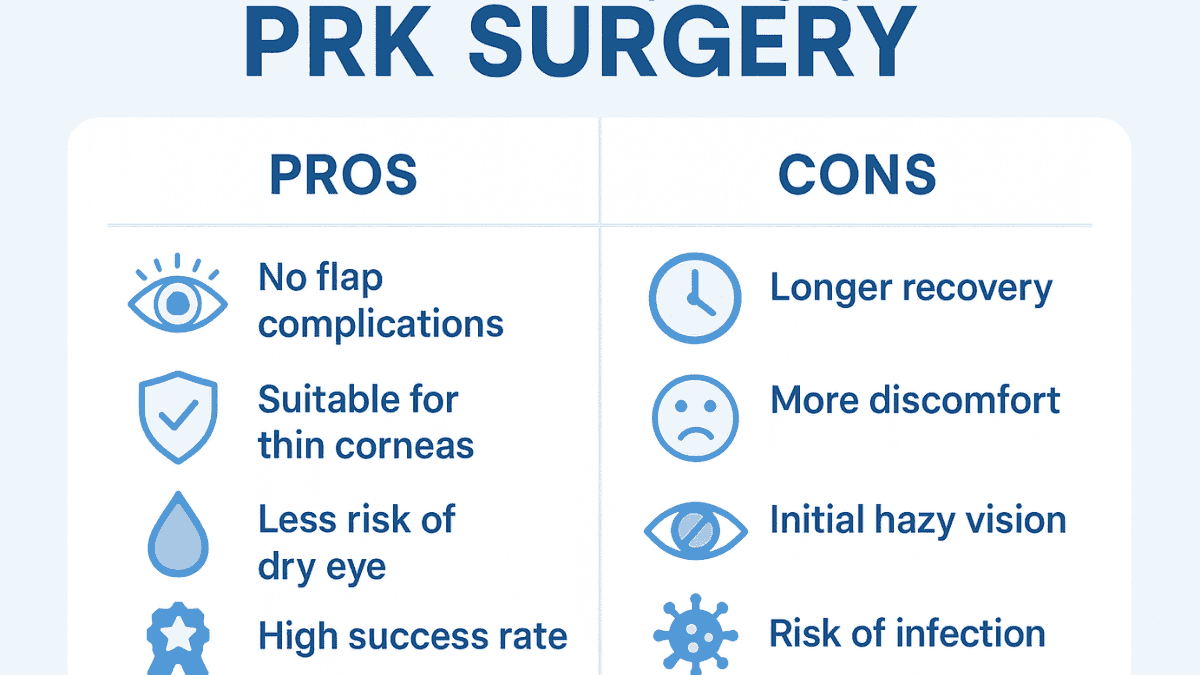
Like any medical procedure, photorefractive keratectomy has its distinct advantages and potential disadvantages. Understanding these can help you make an informed decision in consultation with your eye surgeon. Many benefits of PRK include long-term stable vision.
Pros:
- Can correct a wide range of vision problems. PRK is highly effective for correcting myopia (nearsightedness), hyperopia (farsightedness), and astigmatism, including some instances of high refractive errors that might not be suitable for other laser procedures. This makes it a versatile option for laser vision correction.
- Good option for people with thin corneas. Since no corneal flap is created, the structural integrity of the cornea is better preserved. This makes PRK a safer and often preferred laser procedure for individuals with thinner corneal tissue where LASIK might be contraindicated.
- Lower risk of certain complications compared to LASIK. Specifically, PRK entirely avoids risks associated with the corneal flap, such as flap displacement, wrinkles, epithelial ingrowth, or inflammation beneath the flap (diffuse lamellar keratitis).
- No risk of flap-related issues. This is a significant advantage, particularly for individuals in professions (e.g., military, law enforcement) or engaging in activities (e.g., contact sports) with a higher risk of direct eye trauma, as there’s no flap that can be dislodged. The cornea grows back its outer layer naturally and smoothly.
Cons:
- Longer recovery time than LASIK. Vision takes a noticeably longer time to clear, and the initial discomfort post-surgery is generally more pronounced and prolonged. Patients typically require more time off from work and daily activities during the initial healing process.
- More discomfort in the first few days after surgery. The regeneration of the corneal epithelium over the treated eye surface can cause moderate eye pain, light sensitivity, and a persistent foreign body sensation. Effective pain management with prescribed eye drops is crucial during this phase.
- Vision takes longer to stabilize. While some improvement in vision is usually noticed relatively early after the bandage contact lens is removed, the final, stable visual outcome may not be fully apparent for several weeks to months. Fluctuations in vision clarity are common during this extended surgery recovery period, requiring patience.
| Feature | Pros of PRK Surgery | Cons of PRK Surgery |
|---|---|---|
| Vision Correction Range | Effective for a wide range of refractive errors, including high refractive error. | Vision stabilization takes longer to achieve. |
| Corneal Thickness | Suitable and often the preferred laser option for patients with thin corneas. | N/A |
| Flap Complications | No risk of corneal flap complications as no flap is created. | N/A |
| Recovery Time | Avoids any potential long-term flap concerns or weaknesses. | Longer overall recovery period compared to LASIK, with more initial restrictions. |
| Initial Comfort | N/A | More initial discomfort and eye pain during the first few days as the outermost layer heals. |
| Activity Level | Considered better for individuals in high-contact sports or activities post-full healing. | Initial downtime and activity restrictions are more significant. |
Potential Risks and Side Effects
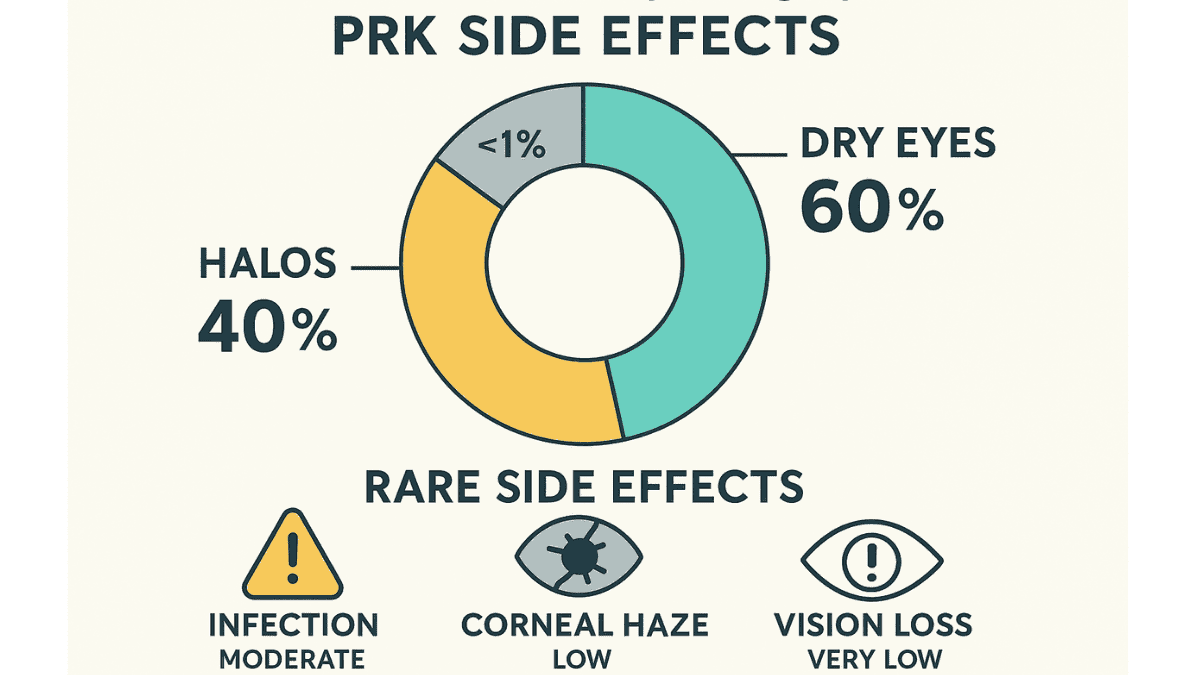
While photorefractive keratectomy surgery is widely regarded as a safe and effective refractive surgery, like any surgical procedure, it carries potential risks and side effects that must be considered. An experienced eye surgeon will discuss these thoroughly with you during your pre-operative consultation. Understanding these potential issues can help you make an informed decision about your eye care and vision correction options.
Common, and usually temporary, side effects include experiencing dry eyes. Many patients report symptoms of dry eye after PRK, which can often be managed effectively with frequent use of lubricating eye drops (artificial tears) and may resolve over several months as the eye surface heals. In some instances, dry eye symptoms can persist for a longer duration, requiring ongoing management. Some individuals may experience more significant dry eye if they had it before surgery.
Glare, starbursts, or halos around lights, particularly noticeable at night or in low-light conditions, can occur. These visual disturbances are more common in the early recovery period and typically diminish gradually as the eye fully heals and adapts. However, in a minority of cases, these symptoms can be a longer-term issue affecting night driving or comfort in dim environments. Another potential issue is corneal haze, a subtle cloudiness of the cornea that can occur as the eye heals, potentially affecting vision clarity. While mild haze is common and usually clears with time or medicated eye drops, more significant or persistent corneal haze might require additional treatment, though this is less common with modern laser technology and post-operative medication protocols. Corneal scarring is another rare but more serious possibility that could impact vision.
Under-correction or over-correction of your refractive error is also possible. This means your vision may not be perfectly corrected to the desired level, and you might still require glasses or contact lenses for certain activities, such as reading or driving, especially if you had a very high refractive error initially. In some cases, an additional laser enhancement procedure could be considered after the eye has fully stabilized if the residual refractive error is significant. Infection is a rare but serious risk associated with any eye surgery. Adhering strictly to post-operative care instructions, particularly the diligent use of prescribed antibiotic eye drops according to the drug administration schedule, significantly minimizes this risk. Signs of a corneal infection, such as increasing pain, redness, discharge, or worsening vision, require immediate medical attention from your eye surgeon.
How Much Does PRK Surgery Cost?
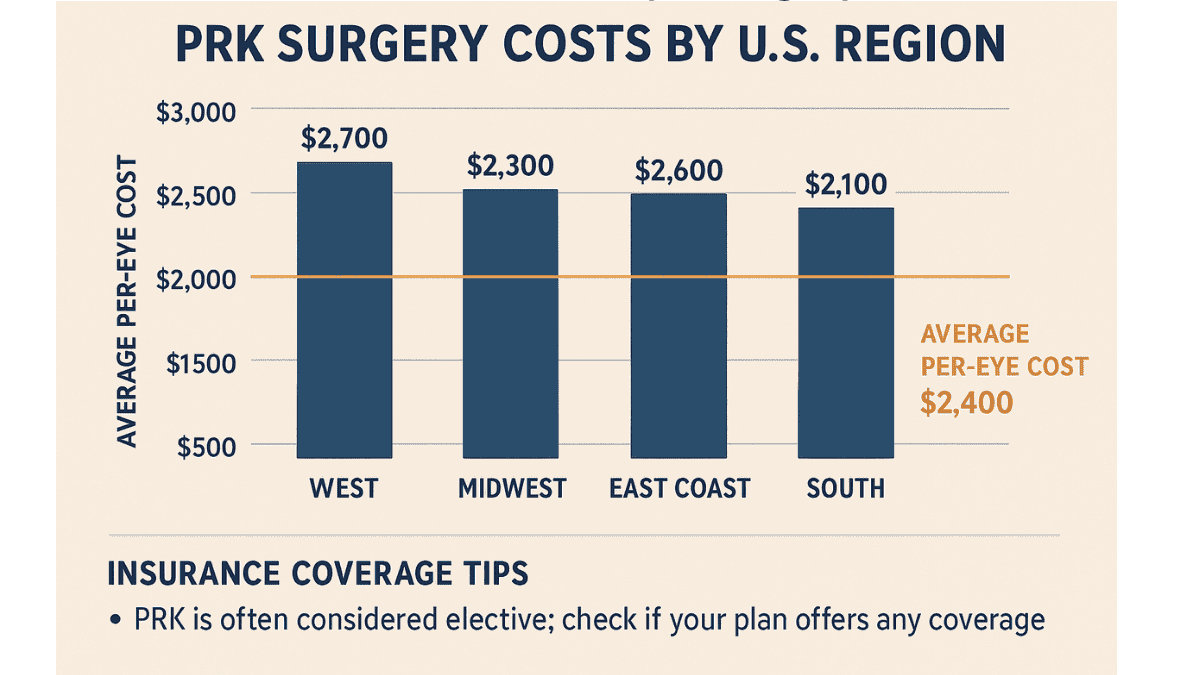
The financial investment required for PRK laser eye surgery can vary considerably. Factors influencing the cost include the geographical location of the clinic, the experience and reputation of the eye surgeon, and the specific laser technology utilized at the surgery center. Generally, the cost for PRK surgery ranges from approximately $1,500 to over $3,000 per eye. This fee typically encompasses the pre-operative consultations and detailed eye exam, the surgery procedure itself, all post-operative follow-up visits for a specified period, and sometimes the cost of initial medications like eye drops.
Most health insurance plans categorize laser vision correction procedures, including PRK and LASIK, as elective. This means they are not considered medically necessary and therefore insurance companies typically do not cover the cost. However, it is always beneficial to check directly with your specific insurance provider, as some vision plans may offer partial coverage, a fixed benefit, or a percentage discount for refractive surgery. Utilizing funds from a Flexible Spending Account (FSA) or a Health Savings Account (HSA) can be an effective way to pay for PRK with pre-tax dollars, potentially offering significant savings. Many eye care clinics and surgery centers also offer financing options or payment plans to help patients manage the expense of the procedure over time, making it more accessible.
Preparing for PRK Surgery
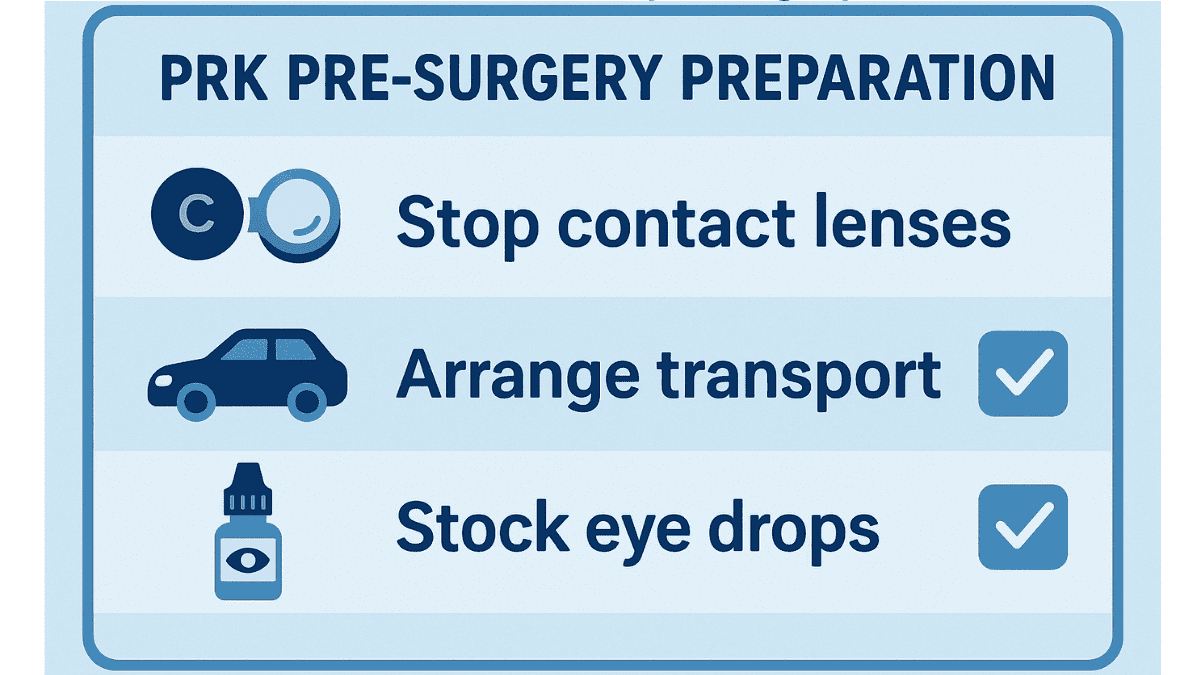
Proper preparation is an important step for a smooth PRK surgery experience and achieving an optimal visual outcome. Your eye surgeon and their clinical team will provide you with detailed, personalized instructions based on your specific health profile and eye condition. Adhering closely to these guidelines is a crucial part of your laser photorefractive keratectomy journey and contributes significantly to the success of the procedure.
If you currently wear contact lenses, you will need to discontinue their use for a specific period before your comprehensive pre-operative eye exam and again before the surgery itself. Contact lenses can temporarily alter the natural shape of your cornea’s surface, and the cornea needs to return to its undisturbed state for the highly accurate measurements required for planning the laser treatment. The duration for which you need to avoid contact lens wear varies: soft contact lens wearers might need to stop for one to two weeks, while those who wear hard (PMMA) or rigid gas permeable (RGP) lenses may need to abstain for a longer period, often three weeks or more per lens type.
You must arrange for reliable transportation to and from the surgery center on the day of your procedure. Your vision will be blurry immediately after the PRK laser surgery, and you will have received medication that can impair your ability to drive safely. Plan to take some time off from work, school, or other demanding daily activities to accommodate the initial recovery phase; typically, 3 to 5 days are recommended for rest and initial healing, but this can vary depending on your job and individual healing rate. It’s wise to stock up on preservative-free artificial tears and any prescribed eye drops beforehand so you have them ready. You should also prepare by having a pair of comfortable, dark sunglasses available to wear immediately after the laser surgery, as your eyes will be very sensitive to light. Having realistic expectations about the recovery timeline and potential visual fluctuations is also an important part of mental preparation. You’ll be asked to focus on a target light during the procedure.
Life After PRK Surgery
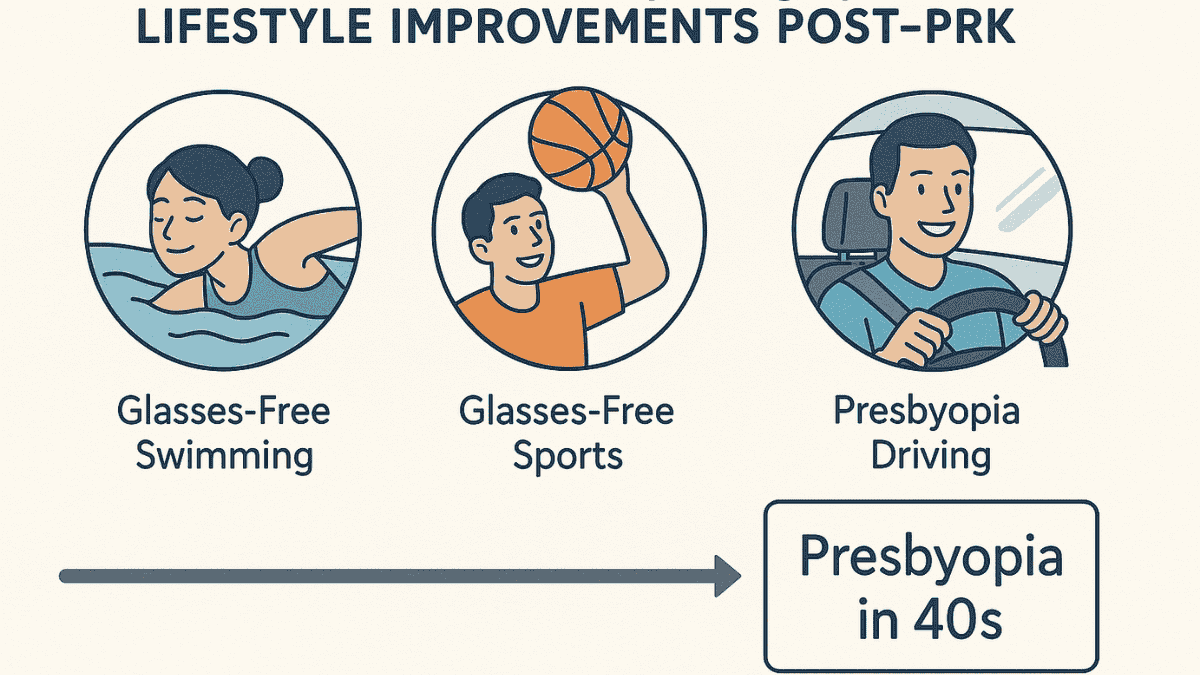
Life after photorefractive keratectomy (PRK) often brings a profound and positive change in daily living and overall quality of life for many individuals. The primary objective of this laser eye surgery is to significantly reduce or completely eliminate the lifelong dependence on corrective eyewear such as glasses or contact lens wear. The simple act of waking up in the morning with clear vision or performing daily activities like reading, driving, or recognizing faces from a distance without first reaching for glasses can be a remarkably liberating and empowering experience. This vision correction aims to fix your refractive error.
Many patients who undergo PRK eye surgery report very high levels of satisfaction with their corrected vision, finding new enjoyment in activities that were previously cumbersome or difficult with corrective lenses. Activities such as swimming, participating in various sports, or enjoying outdoor adventures like hiking and skiing become more convenient and pleasurable without the worry of glasses fogging up or contact lenses drying out or getting lost. The absence of a corneal flap, a characteristic feature when lasik involves creating one, means fewer long-term restrictions on activities once the eye is fully healed, which is particularly beneficial for those with active lifestyles or in physically demanding professions. The laser removes corneal tissue precisely for lasting results.
However, it is important to maintain realistic expectations and understand that PRK surgery, like any medical intervention, is not a universal guarantee of achieving perfect 20/20 vision for every individual, nor does it halt the natural aging process of the eyes. As individuals typically reach their 40s or 50s, they may develop presbyopia. This is a common, age-related condition that affects near vision (e.g., for reading or close-up tasks) and often necessitates the use of reading glasses, regardless of having had previous PRK surgery to correct distance vision. Additionally, while PRK aims for long-term, stable vision correction, minor changes in vision can still occur over many years due to natural eye changes. In some infrequent cases, an additional laser procedure, often called an enhancement or touch-up, might be considered years later if the vision changes significantly or if the initial correction was not optimal. Regular comprehensive eye exams with your eye care professional remain crucial throughout your life to monitor your overall eye health, check for any new vision problems, and ensure your corrected vision remains stable. Understanding these aspects helps in forming a balanced view of the long-term benefits and considerations of this effective refractive surgery.
Conclusion
PRK surgery, also known as photorefractive keratectomy surgery, represents a significant advancement in vision correction technology, offering a reliable path to clearer sight. It can be life-changing for many people struggling with vision problems such as myopia, hyperopia, or astigmatism. Although the surgery recovery is typically more extended and involves more initial discomfort compared to some other refractive surgery options like LASIK, the lasting benefits of improved vision without daily reliance on glasses or contact lenses often make it a worthwhile choice for suitable candidates, especially those with thin corneas or active lifestyles.
A thorough consultation with an experienced eye surgeon is the essential first step to determine if this specific prk laser surgery is the most appropriate and safest option for your individual eye care needs and vision goals. This professional will conduct a comprehensive eye exam and discuss all aspects of the procedure, including potential outcomes and risks. With informed decisions, realistic expectations about the healing process, and diligent adherence to post-operative care, including the use of prescribed eye drops, PRK can significantly reduce dependence on corrective lenses and enhance your overall quality of life. PRK laser eye surgery can indeed be a gateway to visual freedom and a brighter outlook.
FAQ
PRK stands for Photorefractive Keratectomy, a type of laser vision correction that reshapes the cornea.

PRK does not involve creating a corneal flap, unlike LASIK. It reshapes the cornea’s surface after removing the outer layer.

People with thin corneas, active lifestyles, or those not eligible for LASIK are ideal candidates for PRK.

You won’t feel pain during the procedure due to numbing drops, but discomfort is common during recovery.

The procedure typically takes 15–30 minutes for both eyes combined.

Most patients recover within 1–3 months, with initial healing in the first 7 days.

Many patients achieve 20/20 vision, but some may still need glasses for reading or night driving.

PRK surgery ranges between $1,500–$3,000 per eye depending on region and surgeon.

Yes, PRK is often preferred for thin corneas since it avoids flap creation.

Dry eyes, glare, and fluctuating vision are common but usually temporary side effects.

Yes, PRK is effective for correcting mild to moderate astigmatism.

Discontinue contact lenses and follow your surgeon’s instructions regarding drops and recovery prep.

Yes, both eyes are typically treated in the same session for convenience and recovery alignment.

Yes, PRK has been FDA approved since the 1990s and is widely recognized as safe.

Risks include undercorrection, glare, corneal haze, and rare infections.

Many patients return to work within 5–7 days, but screen use may still be limited.

Some patients experience halos or glare at night, especially during the first months.

Vision may change slightly over years, but most patients enjoy long-lasting results.

Light activity can resume in a few days, but avoid strenuous workouts for at least 2 weeks.

Most insurers do not cover PRK since it’s considered elective, but FSAs/HSAs may apply.



